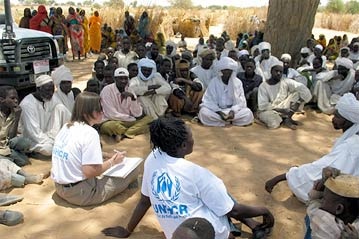Lesson plans for ages 15-18 in Civic Education: Refugee Women and Girls
Lesson plans for ages 15-18 in Civic Education: Refugee Women and Girls
-

As a group of displaced women wait in the background, two UNHCR female protection staff meet with displaced men in Sudan's Darfur region to discuss shelter needs and other concerns.
LESSON 1: Perceptions of Women and Girls in Different Communities
Preparation
My Son, My Son, a six sentence story for every pair of students, each sentence appearing on a separate slip of paper:
- There is a road accident.
- A lorry ran over a man and his son.
- The father was killed outright.
- The boy was taken to hospital.
- The surgeon at the hospital recognised him.
- 'My son,' cried the surgeon, horrified, 'that's my son.'
Overhead transparency or copies of "The Universal Declaration of Human Rights in simple language" (to be referred to when needed).
Run off copies of "Two steps forward, one step back" and "Outside, looking in".
Procedure
To gain the maximum effect with the introductory activity, it would be better not to tell the students the title of this unit, yet.
Arrange the students in pairs, and give each pair the six slips of paper with the six sentences that make up "My Son, My Son, but in a jumbled order. The students have to arrange the sentences in a sequence that makes sense. Those pairs who finish quickly should not divulge their solution to the problem. After a few minutes those who are struggling could be asked to express their difficulties.
This is a simple, but very effective means of stimulating discussion about sex roles and stereotyping, and of illustrating the idea that we tend to view the world on the basis of a fixed set of assumptions. Some pairs will probably work out the 'answer' (that the surgeon is the boy's mother), but there will usually be a number who fail to solve the problem, or who offer a tortuous alternative solution, and who will be startled when they are told. There in lies the power of this exercise: the sudden self-discovery of one's own assumptions and limited perspective. Because of the 'trick' element of this exercise, it may need to be handled with some sensitivity, particularly for those who did not get the 'right answer'.
The discussion questions lead the students through a quick review of what are basic human rights, and then encourage the students to consider how denial of certain basic rights for women can exist within a social structure. The homework reading provides examples of such a situation.
Discussion questions
The most simple solution to the mystery in "My Son, My Son" is that the surgeon is the mother, yet the solution is not the most obvious. Give your reasons why this is so.
In western societies, professions such as surgery and law are dominated by men. What factors in the lives of women contribute to their absence in these fields?
Every individual in the world has basic human rights. What are some of them? (Refer to The Universal Declaration of Human Rights).
Women have to fight sexism within their own culture. Which human rights are denied by sexism?
How can our communities ensure that women are able to realise their basic human rights, such as the right to choose whether and when to bear children, and the right to work.
For homework, and as a link between lessons 1 and 2, ask the students to read the article entitled "Fighting for Equal Rights..." and to complete the accompanying homework questions in preparation for lesson 2.
Homework questions
1. List the countries the refugees come from, and the countries in which they have sought safety.
2. Describe the attitude of the women concerning themselves - select some key words for this description.
3. Describe the attitude of the male humanitarian workers mentioned in the article.
4. Make a list of the various duties that you consider a refugee woman has to do in her daily life.
5. List some of the hardships refugee women have to face.



